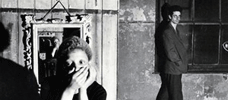Reviews
Sally Potter
UK / France / Argentina / Germany / Netherlands, 1997
Credits
Review by Rumsey Taylor
Posted on 17 February 2008
Source Sony Pictures Classics VHS
Categories The Lyricism of Sally Potter
The stark black and white palette in Sally Potter’s The Tango Lesson is illustrative of dichotomy, one between the professional and the personal, the imagined and the real, the masculine and the feminine, and in a more literal sense the two languages - English and French - spoken almost at once in much of the film. There’s no real conflict between any of these elements; rather, the film is about harmony, the attempt toward reconciliation. Metaphorically this dichotomy is satisfied by the tango.
There is much dancing in the film. Often, the action at hand will inspire dance sequences in a kitchen, a rainy street, or in a particularly playful instance an airport moving walkway. These sequences are summoned with whimsy and improvisation, but the tango has a larger utility here, demonstrating the back-and-forth of a female filmmaker’s propulsive relationship with her tutor. Potter herself, of course, is the filmmaker in question, and partners herself with Pablo Veron, an expressive dancer of Argentinean descent. “You know, I always wanted to be in films,” he says to her, and she responds accordingly: “You know, I always wanted to be a dancer.”
Sally is drawn to the tango rather coincidentally, having encountered some difficulty in writing her latest film. As she’s working on this, her imagination is expressed abruptly onscreen in vibrant, color photography: we see a trio of women in gowns prancing about the gardens of some wealthy estate. They are consecutively dressed in bold primary colors, and are chased invariably by a fashion designer (who curiously has no legs, and rather frightfully recalls Johnny Eck in Freaks) or some photographers. This vision is episodically repeated as Sally returns to her London flat (after tangential visits to Paris and Buenos Aires, to dance, naturally) to work, and is interrupted regularly by leaks in her ceiling or creaky floorboards. As the renovation increases it affects her film—the three women are each murdered gruesomely. The spectrum of Sally’s entire imagination is reduced, becoming less ambiguous, and she becomes fond of the tango initially for its instruction, and not imagination.
The dancing is something of a tangent for Sally, and inevitably - as two pairs of legs hustling past each other - the leisure becomes indistinguishable from her work—or rather, it becomes realized that they were never disparate to begin with. Sally’s struggle in her work is one of creation, and the same can describe Pablo’s dancing. He is hypercritical in instructing Sally—she is present in his realm of expertise, and must subscribe to his perception of order. This relationship is inverted eventually, once Sally considers making her next film about tango, featuring Pablo in a prominent role. Consequentially, one partner must lead the other, but both must collaborate.
Collaboration proves difficult, and examples The Tango Lesson’s principle concern in how the tango is a sublimation of one’s instincts, both personally and professionally. The tango can never be purely anonymous; it must be imparted with life. The same applies to Potter’s film. Potter’s presence in it is more conceptual utility than it is performance—it is transparently autobiographical, and Potter is honest in indulging both her inspirations and insecurities. As Sally sings to her lover/partner/muse in the final scene - she dressed in all white, he in all black - one is left with the thought that great satisfaction derives from great struggle.
More The Lyricism of Sally Potter
We don’t do comments anymore, but you may contact us here or find us on Twitter or Facebook.








